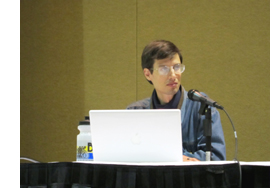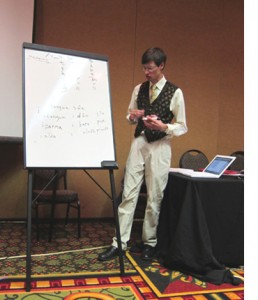
Geek Kon is a relatively young gathering, started in 2007 by students and alumni of the University of Wisconsin-Madison. The fifth con was held this weekend, September 9 to 11, with 1400 fans attending. There were three Tolkien-related events, allinvolving David Salo, an expert on the professor’s invented languages.
David’s main contribution to the scholarly study of those languages has been his book A Gateway to Sindarin. He also, however, acted as the “Tolkien linguist” for Peter Jackson’s film adaptation of The Lord of the Rings. In that capacity, he translated phrases and passages from the script into various Middle-earth languages, primarily Elvish. David also devised passages in Khuzdul (the secret language of the dwarves), including choral portions in the musical score for the scenes in Moria. David also translated the phrases seen engraved on the swords and other armaments, and he recorded readings of his translations for the language coaches to use in training the actors.
(I have known David for years, and in September of 2004 I interviewed him for my book, The Frodo Franchise. I used material from that interview in Chapter 3, “Handcrafting a Blockbuster,” pp. 95-6.)
I don’t think it has been publicly announced yet, but fans will be delighted to know that David is currently performing the same tasks for The Hobbit. Although his contract obviously restricts him in what he can say about the actual filming, his first talk shared with us what he could reveal.
Session 1: “The Hobbit” (September 9)
David is affiliated with the University of Wisconsin, in my home town of Madison, and he has done all his work on the film from here. In fact he has never been to New Zealand. So, as he started by saying, he has no inside information about the filming currently going on there. He works via email and is usually in touch with script editors and people in the props and art departments. The way the system works is that at intervals, he is sent short passages to translate. He never sees the whole script but only “a couple of lines” in most cases. The lines tend to be sent in batches; in between, he simply waits for the next batch.
What little he could tell us about The Hobbit is this. There are props and maps that will need to have writing on them, but that work has not yet been given to him. Similarly, he expects to be asked to write lyrics for choral passages of the musical score, but again, that has not happened yet. So far he has worked primarily on lines of dialogue, and just two days before his talk had sent back a batch of translations.
David went on to describe—without using specific examples from either film—the methods he uses for translation.
Translation into Middle-earth languages differs from methods used with real-world languages, of course. As David says, “In a way this language doesn’t have the sort of stability that real-life languages do.” Even Tolkien was not a “native speaker” of the languages he invented. He would examine and sometimes change the structure of sentences he was translating. Tolkien’s manuscripts show that he would try out numerous spellings of any given word, and we can’t be sure that the one he used in a draft would have been his final choice.
Thus David cannot call upon known facts about these languages. He is a professional linguist, however, and uses the same sorts of techniques that Tolkien himself would have employed. The result is what David calls “an approximation” of how an elf’s speech (Sindarin) might sound.
David’s work begins when he identifies the key words in a sentence and rearranges them into a different order that corresponds to the structures of Sindarin. He then translates the individual words. David knows a few hundred by heart, but he often refers to a much larger list he has on his computer.
But not all English words have known Sindarin equivalents. David has to make up words to fill in the sentences he needs to translate. Often he bases these on known roots and structures of the language.
In other cases, he refers to Tolkien’s other main Elvish language, Quenya. Like real-world languages, Quenya and Sindarin have a mutual ancestor in “Common Eldarin.” For real languages that share a common ancestor, linguists can trace back from the more recent forms to reconstruct the original ones. Tolkien’s languages are based on similar principles, and so David can attempt to reconstruct a Common Eldarin version of a Quenya word, and then trace in reverse how that word would have evolved in Sindarin. It’s a complex and fascinating process that shows just how much expertise and effort went into the translations used in the Lord of the Rings film—and is now going into those used in The Hobbit.
The process for translating into the dwarvish language, Khuzdul, is more tentative. Still, it may be particularly important for The Hobbit, which involves many dwarves as characters. David pointed out that the number of known Khuzdul vocabulary words is small enough to fit on a single page. But even such a limited set of words is useful, in that it sets restraints on what David does as he inevitably invents words: he knows what words would not sound like Khuzdul.
He also knows that Khuzdul is based upon a specific language type: Semitic (Hebrew, Arabic, and so on). Such languages have distinctive ways of ordering words, for example, with the adjective following the noun.
David has been working on Khuzdul since the 1990s, when he contributed translations for the now-defunct Iron Crown Enterprise’s Lord of the Rings role-playing game. Some of the Khuzdul names he devised then were re-used for The Lord of the Rings. Perhaps they will crop up in The Hobbit as well.
David’s attempts to devise speech in Orcish are based on even fewer words available from Tolkien’s own writings. He followed the general principle of making the language “harsh and strong and ugly.” The writing on the Ring does not reflect the way orcs talked. There were many types of orcs, and as a result their language would have rapidly changed into different dialects. For The Lord of the Rings, David devised three types of Orcish language, for those of Moria, Orthanc, and Minas Morgul.
He plans to create new Orcish language for the goblins in The Hobbit. These creatures would be a northern branch of the orcs, borrowing words from dwarves, men, and even elves in the same region.
Session 2: “Tolkien Panel” (September 9)
In this informal panel, David Salo was joined by Jim Frenkel, a senior editor at Tor Books, which specializes in science fiction and fantasy. The two discussed the general topic of Tolkien’s impact on the genre of fantasy. They pointed out than when The Hobbit was published, the genre of “fantasy” did not exist. Some highlights:
DS: “He writes The Hobbit, and for the very first time, I think, people are seeing all together, within the covers of one book, all these tropes which we now consider to be basic fantasy tropes. You’ve got your hero, who is a small individual who doesn’t seem to be of much account but he changes the world. You’ve got your elves and your dwarves and your wizards and your dragons. Nowadays it must seem like that’s totally derivative. ‘Tolkien? He’s not coming up with anything new.’ But in fact, in 1937, it was new.”
JF: “One of the things I was thinking about was—we’ve had this conversation at Tor—that if Tolkien started writing today, people would not be nearly as impressed, because there’s so much that’s been published since Tolkien that’s derivative of Tolkien that he basically gave us an entire minor genre, the genre of epic heroic quest fantasy. (You could define it with different words.)
“The whole idea of people working with magic, overcoming all sorts of tremendous odds to acquire something of tremendous value at great risk to themselves, starting from humble beginnings and changing the world, essentially, or saving the world. How many times have you seen the copy on the back cover of a paperback saying all those things? But before Tolkien, nobody really did this.”
The pair also touched on specific works that would not exist were it not for Tolkien. Jim commented, “There are people who wouldn’t have careers without Tolkien. Terry Brooks would not have a career without Tolkien.” He also pointed out that Peter Jackson’s films have been enormously influential: “I have no doubt that we would not have the terrific adaptation of George R. Martin’s Game of Thrones if it hadn’t been for the enormous success of Lord of the Rings, because Game of Thrones on HBO cost a fortune to mount.”
Session 3: “Elvish Writing and Conversation” (September 10)
 This was a talk that David has clearly given before, introducing people to his work specifically on “Elvish” languages. I can’t possibly convey the complex examples through which he presented this work, though the audience clearly was absorbed in his explanation.
This was a talk that David has clearly given before, introducing people to his work specifically on “Elvish” languages. I can’t possibly convey the complex examples through which he presented this work, though the audience clearly was absorbed in his explanation.
Basically he began by pointing out that there is no such thing as an “Elvish” language. He diagrammed how Primitive Quenya divided into Eldarin and Avarin. Of the latter, few words are known. Eldarin is essentially “Common Eldarin,” the ancient, unknown language from which other Elvish languages descended, the most important being Quenya (associated with the Noldor) and Sindarin (associated with the Elves who stayed in Belariand).
David then compared many words in Quenya and Sindarin, showing which traits they shared and which were different. The shared traits are those which must have been characteristic of their ancestor, Common Eldarin. The differences show how the two languages evolved along separate lines. Further comparisons showed apparently inconsistent changes, which are more difficult to interpret in terms of how Quenya and Sindarin evolved from a common ancestor.
None but experts like David can trace such changes. Still, the main point to be learned here develops on what David demonstrated in his first talk. Tolkien created languages for his fantasy world that behave like languages in the real world. Linguists can trace back commonalities in languages and reconstruct ancient languages that are now lost. That was what Tolkien did as a scholar. As a writer of fiction, he also took real ancient languages and traced forward what certain words would have become had they stayed in use. Many of the words and names in his novels were created in this way. David uses similar techniques to create names and inscriptions and translations for Peter Jackson’s films.
Listening to David’s talks, I was reminded of how brilliant Tolkien was in mapping the traits of real-world languages into the invented ones he created for his books. I was also reminded of how diligent the filmmakers have been in calling upon an expert such as David to apply similar techniques in transferring those languages into their adaptations. Certainly they could have simply settled for using English in all cases and ignoring Tolkien’s languages altogether.
(This is my first report for TheOneRing.net. Thanks to Calisuri for inviting me to join the staff and to all the staff members who have written to welcome me aboard!)


